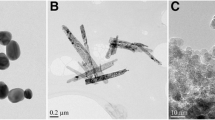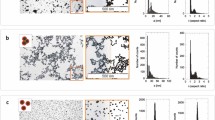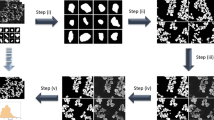Abstract
Multiple methods have been developed to estimate size and shape of nanoparticles from transmission electron microscopy images. However, some of them have limiting characteristics such as hard to use, expensive or have steps that make the results unreal. We present here a comparison of a manual (IMAGEJ) and an automated analysis, both free methods. The gold nanoparticles were synthesized by the traditional Turkevich method using sodium citrate. We used 23 images of gold nanoparticles. The results of our study show that the conglomerated particles can be excluded—given that a sufficient amount of particles is included in the analysis. We show that CellProfiler can be highly efficient to assumptions about size and shape of nanoparticles. These findings provide a new approach of free software that can be applied as machine learning and therefore automate the processing of nanoparticles data.
Similar content being viewed by others
Avoid common mistakes on your manuscript.
Introduction
Nanoparticles are defined as material between 1 and 100 nm in size with a mass of 105 atoms (Issa et al. 2013). Nanoparticles are known to have a wide range of diagnostic and therapeutic applications. As examples, vascular and tumor imaging, drug delivery and iron supplement may be mentioned (Arami et al. 2015). The strong interest in nanoparticles results from the unique physical properties such as the area of their surface and the surface tension (Paranjpe and Müller-Goymann 2014. The therapeutic effect of nanoparticles, however, is strongly dependent on their size (de Jong et al. 2008; Dwivedi et al. 2014). The importance of nanoparticles including quality control was mentioned in the recent literature (Kite et al. 2019; Patil and Bhosale 2019; Patil et al. 2018, 2020). This frequent control of the synthesized nanoparticles is therefore a condition to maximize the therapeutic effect (Nischwitz and Goenaga-Infante 2012; Vippola et al. 2016). The gold standard for quality control is the analysis of images created by transmission electron microscopy, scanning electron microscopy, scanning transmission electron microscopy, small-angle X-ray scattering, wide-angle X-ray scattering, atomic force microscopy, or dynamic light scattering (Vippola et al. 2016). The nature of the image analysis may be manual or automated. A manual analysis is tedious, time-consuming and, most important, not reproducible. An automated analysis on the other hand is reproducible, fast and manages bigger sample sizes (Buzin et al. 2015, 2017; Macedo et al. 2017). Last, not least, the automated analysis does not require a highly educated specialist, resulting in a more inexpensive analysis. A recent study stated the inability of common image analysis software to identify agglomerated nanoparticles. To this end, the authors developed a software capable of identifying single nanoparticles also when agglomerated. The authors compared their results with ImageJ and a manual analysis (Vippola et al. 2016). The results of the three methods seemed comparable. Gold nanoparticles (AuNPs) have been researched for applications in medical images, according to recent research; they are considered image contrast agents that benefit clinical practice (Han et al. 2019).
The authors of the present study hypothesized that agglomerated events might be excluded from an automated analysis, given, that a sufficient quantity of nanoparticles per sample is analyzed.
The aim of the present study is to analyze shape and size of nanoparticles with a free software for image analysis and subsequently compare the results with those of a manual analysis.
Sample preparation
In Synthesis and characterization of gold nanoparticles.
Gold nanoparticles (AuNPs) were synthesized based on (Turkevich et al. 1951) method with modifications. Briefly, 15 mL of chloroauric acid (HAuCl4, Merck Co. Ltd., Brazil) at 2.5 × 10−4 M was maintained under agitation (200 rpm). The gold precursor was reacted with 1 mL of trisodium citrate dihydrate at 1% m/v (Na3C6H5O7·2H2O, Merck Co. Ltd., Brazil) for 15 min at 100ºC. The solution was cooled in ice bath for 30 min. AuNPs were collected, and their optical properties were evaluated by UV–vis spectroscopy (FEMTO 800 XI). Size and morphology were examined by transmission electron microscope (JEOL, JEM-1400) operated at 120 kVwith Lab6 filament. AuNPs were characterized using ImageJ and Cellprofiler.
Materials
ImageJ
The monodispersity of the AuNPs was determined based on the aspect ratio manually (major axis length and minor axis length) using the ImageJ software as shown in Fig. 1.
CellProfiler
The automated analysis was conducted using the free software CellProfiler (version 2.1.1) and analyzed 23 images (N = 423 nanoparticles), and each image was processed individually.
The identified objects that did not reach a certain minimum in terms of a user-defined, image-dependent form factor were not included in the subsequent analysis, as described in Table 1 (5-Filter Objects):
The original image, the initial identification and the result of the filtering are depicted in Fig. 2.
Results and discussion
A quality control, i.e., a morphological analysis of nanoparticles was conducted manually and automated. A mean of the values is described in Table 2. Subsequently, the results were compared. The results of the comparison are depicted (Fig. 3).
A Bland–Altman graph for the comparison of manual and automated analysis. The compared parameters were minor axis length divided by the major axis length. The x-axis represents the media of the two analyses; the y-axis represents the difference between the two analyses. The middle line of the y-axis represents the mean of the differences ( − 0.01). The upper and lower lines are mean ± 1.96 *standard deviation of the differences
The Bland–Altman assay shows the mean of the differences is close to zero. There is no systematic bias, i.e., the differences are mean, above and below the mean. The higher the mean, the smaller the differences between the two methods. Almost all the differences are within mean + 1.96 *standard deviation, i.e., the differences are normally distributed (Fig. 4).
The median of the manual method was 0.94, and in the automatic method, it was 0.97, as shown in the graph by the central line. The automatic method showed a more symmetrical distribution than the manual method. There is also a low variability and low standard deviation compared to the manual method.
The effect of nanoparticles is strongly dependent on their size (De Jong et al. 2008; Dwivedi et al. 2014). A frequent quality control of the synthesized nanoparticles is therefore a very important measure to maximize the effect of the objects (Nischwitz and Goenaga-Infante 2012; Vippola et al. 2016).
For the present study, a quality control, i.e., a morphological analysis of nanoparticles was conducted manually and automated. Subsequently, the results were compared. The data of the present study indicate that the results of the manual and automated analysis are comparable. In a recent study, a software was developed, capable of conducting a quality control of nanoparticles including the identification and analysis of single objects even when conglomerated (Vippola et al. 2016. The authors had compared the results obtained with their new software with those of the software imageJ and a manual analysis. The results of the three different methods seemed comparable; however, no statistical analysis of the comparability of the results was conducted. As the authors of the present study hypothesized that conglomerated objects can be excluded, the results of the present study indicate that the results of a manual analysis, including conglomerated objects, are comparable to those of an automated analysis that excluded conglomerated objects.
Conclusions
The results of the present study indicate that an automated analysis excluding conglomerated objects may deliver the same results as automated analysis including, given that the first method analyses a representative count of objects. Another conclusion of the present study is that an automated analysis is more accurate and faster as compared to a manual analysis. It may be concluded that there is no necessity to spend labor, money and time to develop a software.
Further comparisons may be necessary to verify the truth of the author’s hypothesis of the present study.
References
Arami H, Khandhar A, Liggitt D, Krishnan KM (2015) In vivo delivery, pharmacokinetics, biodistribution and toxicity of iron oxide nanoparticles. Chem Soc Rev 44(23):8576. https://doi.org/10.1039/c5cs00541h
Buzin AR, Macedo ND, De Araujo IB, Nogueira BV, de Andrade TU, Endringer DC, Lenz D (2017) Automatic detection of hypoxia in renal tissue stained with HIF-1alpha. J Immunol Methods 444:47. https://doi.org/10.1016/j.jim.2017.02.005
Buzin AR, Pinto FE, Nieschke K, Mittag A, de Andrade TU, Endringer DC, Tarnok A, Lenz D (2015) Replacement of specific markers for apoptosis and necrosis by nuclear morphology for affordable cytometry. J Immunol Methods 420:24. https://doi.org/10.1016/j.jim.2015.03.011
De Jong WH, Hagens WI, Krystek P, Burger MC, Sips AJ, Geertsma RE (2008) ANJAM sips and RE geertsma. Biomaterials 29(12):1912. https://doi.org/10.1016/j.biomaterials.2007.12.037
Dwivedi MV, Harishchandra RK, Koshkina O, Maskos M, Galla HJ (2014) Size influences the effect of hydrophobic nanoparticles on lung surfactant model systems. Biophys J 106(1):289. https://doi.org/10.1016/j.bpj.2013.10.036
Han X, Xu K, Taratula O, Farsad K (2019) Applications of nanoparticles in biomedical imaging. Nanoscale 11(3):799–819. https://doi.org/10.1039/C8NR07769J
Issa B, Obaidat IM, Albiss BA, Haik Y (2013) Magnetic nanoparticles: surface effects and properties related to biomedicine applications. Int J Mol Sci 14(11):21266. https://doi.org/10.3390/ijms141121266
Kite SV, Sathe DJ, Patil SS, Bhosale PN, Garadkar KM (2019) Nanostructured TiO2 thin films by chemical bath deposition method for high photoelectrochemical performance. Mater Res Express 6:026411. https://doi.org/10.1088/2053-1591/aaed81
Macedo ND, Buzin AR, de Araujo IB, Nogueira BV, de Andrade TU, Endringer DC, Lenz D (2017) Objective detection of apoptosis in rat renal tissue sections using light microscopy and free image analysis software with subsequent machine learning: detection of apoptosis in renal tissue. Tissue Cell 49(1):22. https://doi.org/10.1016/j.tice.2016.12.006
Nischwitz V, Goenaga-Infante H (2012) Improved sample preparation and quality control for the characterisation of titanium dioxide nanoparticles in sunscreens using flow field flow fractionation on-line with inductively coupled plasma mass spectrometry. J Anal At Spectrom 27:1084. https://doi.org/10.1039/C2JA10387G
Paranjpe M, Müller-Goymann CC (2014) Nanoparticle-mediated pulmonary drug delivery: a review. Int J Mol Sci 15(4):5852. https://doi.org/10.3390/ijms15045852
Patil SS, Bhosale PN (2019) Optimization and comparative evaluation of optoelectronic properties of hydrothermally synthesized CdIn2Te4 thin films: PEC performance. Mater Res Express 6:126404. https://doi.org/10.1088/2053-1591/ab5500
Patil SS, Mali SS, Hong CK, Bhosale PN (2020) Designing of novel efficient photoactive ternary Zn1-xCu2xSe thin film materials via hydrothermal route: Photoelectrochemical (PEC) cell study. Mater Sci Semi Process 105:104727. https://doi.org/10.1016/j.mssp.2019.104727
Patil SS, Bagade CS, Joshi MP, Kharade SD, Khot KV, Mali SS, Hong CK, Bhosale PN (2018) Facile hydrothermal assisted synthesis of time dependent Cu2S thin films for efficient photoelectrochemical application. J Mater Sci Mater Electron 29:19322–19335. https://doi.org/10.1007/s10854-018-0059-0
Turkevich J, Stevenson PC, Hillier J (1951) Preparation of 2 5×10–4 M gold colloids (sodium citrate reduction method). Faraday Soc 11:55. https://doi.org/10.1039/DF9511100055
Vippola M, Valkonen M, Sarlin E, Honkanen M, Huttunen H (2016) Insight to nanoparticle size analysis—novel and convenient image analysis method versus conventional techniques. Nanoscale Res Lett 11(1):169. https://doi.org/10.1186/s11671-016-1391-z
Acknowledgements
The financial support of CAPES (1740334) is greatly acknowledged.
Author information
Authors and Affiliations
Corresponding author
Additional information
Publisher's Note
Springer Nature remains neutral with regard to jurisdictional claims in published maps and institutional affiliations.
Rights and permissions
About this article
Cite this article
Ribeiro, G.P., Valotto, R.S., de Oliveira, J.P. et al. An inexpensive, automated and reproducible method to conduct quality control in nanoparticles. Chem. Pap. 74, 2821–2824 (2020). https://doi.org/10.1007/s11696-020-01123-3
Received:
Accepted:
Published:
Issue Date:
DOI: https://doi.org/10.1007/s11696-020-01123-3








